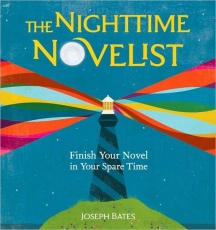 Excerpt
from The Nighttime Novelist: Finish Your Novel in Your Spare Time
Excerpt
from The Nighttime Novelist: Finish Your Novel in Your Spare Time
by Joseph Bates
Checking for Plot Holes
By Joseph Bates,
Author of The Nighttime Novelist: Finish Your Novel in Your Spare
Time
There's a famous story that illustrates how even masterful storytellers can end up with glaring holes in their plots. It concerns Raymond Chandler's classic detective novel The Big Sleep in which the killing of a chauffeur helps launch a series of complex mysteries involving drugs, pornography, blackmail, and murder that Chandler's hero, Phillip Marlowe, must solve. When the novel was later made into an equally classic film starring Humphrey Bogart as Marlowe -- with a screenplay by William Faulkner -- the crew realized during production that there was one last question to resolve: Who killed the chauffeur? As the story goes, director Howard Hawks first called Faulkner wanting to know, who had no idea, so Hawks wired Chandler, the source, and asked him who killed the chauffeur. Chandler's response, as he later recalled, was to-the-point: "Dammit, I didn't know either."
To make sure your plot is as solid as it can be -- before some legendary film director discovers a plot hole while trying to adapt your work -- consider the following questions and see that you have them answered in your novel.
- Have all subplots and supporting character arcs been concluded? You might want to go back through the novel and mark those moments with subplot and supporting cast that seem to demand revisiting later . . . and make sure you did revisit and conclude them in some satisfying way.
- Do you find any of your characters indulging in excessive monologue toward the finale? Late-novel monologues often indicate that certain information should have been introduced earlier but wasn't -- and now your character is trying to catch the reader up on that omitted information in one big breath. These one-breath wonders suggest a hole in the plot that the character is now trying to plug, poorly. Be aware of any such information dumps you come across, and consider how you might plug the hole yourself earlier in the text.
- Do the events in your novel follow the rules of the story as you've set them out? We already discussed rule breaking in terms of the "twist" ending, but the same applies to every turn your story takes. If your protagonist is launched on his adventure when he saves a young woman from drowning, but then at Plot Point 1 he lets the antagonist get away because he's not a very strong swimmer, that's obviously a problem, and everything that comes after that point will be looked on with suspicion by the reader (if he's still reading at all).
- Do the events in your novel follow, and account for, the rules of logic? If it's revealed at the end of your novel that your time-traveling hero has fallen in love with his own grandmother and is now his own grandfather, your reader will likely either scratch his head or kick your novel across the room, depending on what kind of day he's having. It's absolutely true that, as an author, you control the powers of time and space in your book -- see the section on pacing on page 147 -- but even so you're still bound by the general rules of logic; what you do has to make sense. Thus anything that doesn't seem possible, or at least believable, is a problem you'll need to fix.
Sometimes we get so caught up in the momentum of our story, in the fun of telling it, that we forget to properly account for, explain, or excise inconsistencies along the way; even Raymond Chandler can let a dead chauffeur slip past him. But the smallest plot hole might still be big enough for your reader to fall straight through, so be mindful that your plot be as solid as it can be. And if there's anything in the story you can't reconcile, you may want to consider what the offending element is doing there in the first place.
The above is an excerpt from the book The Nighttime Novelist: Finish Your Novel in Your Spare Time by Joseph Bates. The above excerpt is a digitally scanned reproduction of text from print. Although this excerpt has been proofread, occasional errors may appear due to the scanning process. Please refer to the finished book for accuracy.
Copyright © 2010 Joseph Bates, author of The Nighttime Novelist: Finish Your Novel in Your Spare Time.
